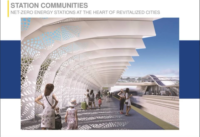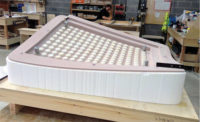The private operator of the Canada Line in Vancouver is using a digital twin of the 19-km-long, 16-station, 12-year-old transit system for predictive maintenance and infrastructure planning. It is the first of its kind for a North American rail system, according to the concessionaire that built and is operating and maintaining the line—InTransitBC, a joint venture of SNC-Lavalin, the Investment Management Corp. of BC, and the Caisse de Depot et Placements de Quebec.
Atkins Global, a member of the SNC-Lavalin Group, began working on the digital twin in 2021. Drones, train-mounted scanners, and remote sensors provide data from key assets to the digital twin. It analyzes the data and identifies critical flaws, creates efficiencies in maintenance, improves safety, and ultimately optimizes passenger flow, says Ryan Versteeg-Biln, director of asset management.
Attempting brownfield implementation of a digital twin for a system that predates the digital era was challenging, he says. “The system was not designed for that integrated information management…. We looked at a user-driven approach: What do we need as operators? What are the pain points?”
In 2005, SNC-Lavalin won the design-build-operate-maintain contract for the fully automated Canada Line. The operations and maintenance part lasts until 2040. The system, built ahead of the 2010 Olympics, has one of the continent’s highest on-time performance rates, at 99.8%, according to TransLink, Metro Vancouver’s transportation network.

Data is constantly fed to the digital twin in real time as trains run.
Photo courtesy of SNC-Lavalin
The “Golden” Assets
Creating the digital twin began with LiDAR scans to identify key assets. “Over 15 years, things change, and drawings didn’t keep up,” says Ron Powell, general manager for Canada Line operations. “Modifications weren’t documented.” In addition to providing an up-to-date asset management system, the digital twin consolidates data from disparate sources, he adds. Now the operator can monitor procurement, purchasing and finances, shipping and receiving, and other workflows.
“The opportunity to connect these data sources into a new framework is a benefit itself,” says Powell. “From there, we can utilize this framework to take us to the next level of controls, operations, maintenance, planning and asset management. You can click on a point cloud and feed information to it. Ultimately it provides you with comprehensive views of everything about that asset.”
One of the key assets are “golden” switches that handle trains every 3 minutes of operation. Every other train heads to the airport, alternating with trains to Richmond, B.C. “If you lose that switch, half your service is done,” Powell says.
Real-time information, including “every swing of the switch,” is fed into this framework; AI-driven algorithms predict when the switch will need maintenance. “There are 71 classifications of assets, and thousands of assets. We’re looking at multiple variables associated with them. Over time we expect [the digital twin] will get even more refined,” predicts Powell.
Versteeg-Biln adds that the idea is to progress with incremental, scalable benefits. Eventually, the digital twin may help in decarbonizing built infrastructure, and “tools developed on the Canada Line can be modified” for other platforms.
TransLink and the British Columbia Rapid Transit Co., which operate the Expo and Millennium SkyTrain lines in Vancouver, “are in close contact with ProTrans BC, the subsidiary of SNC Lavalin that operates the Canada Line, to determine whether digital twinning could improve maintenance and operations,” says a spokesperson.






Post a comment to this article
Report Abusive Comment